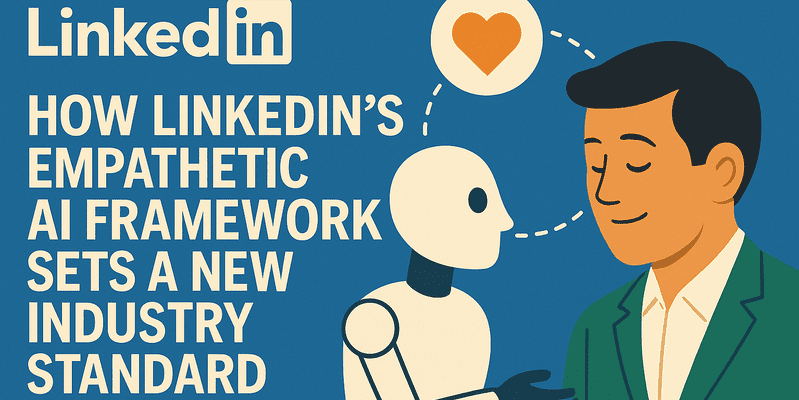How LinkedIn’s Empathetic AI Framework Sets a New Industry Standard

Solutions Review Executive Editor Tim King offers commentary on LinkedIn’s AI framework and how it appears to be setting a new empathetic industry standard.
While many tech companies have faced criticism for allowing AI deployment to outpace ethical considerations, LinkedIn has emerged as a powerful counter-example—a company that is not only integrating AI into its core products but doing so with a deep, principled commitment to fairness, inclusion, and human-centric outcomes. From workforce development to algorithmic transparency, LinkedIn is quietly building one of the most robust empathetic AI policy frameworks in the enterprise world.
Their approach offers a living blueprint for organizations that want to reap the benefits of AI without undermining the dignity, agency, or trust of their users or workforce.
Important: AI Won’t Replace You, But Lack of Soft Skills Might – Get Report
A Commitment to Transparency by Default
At the core of LinkedIn’s AI efforts is a high level of openness about where and how AI is used—particularly in its algorithmic recommendations that shape the job-seeking experience for millions. In a 2023 research paper titled Operationalizing AI Fairness, LinkedIn engineers laid out a formal framework for how to audit, monitor, and explain fairness across multiple dimensions—including race, gender, and socio-economic background.
Rather than treat AI as a black box, LinkedIn:
-
Publishes explainers on how AI determines job matches or feed rankings
-
Offers users control over what influences their job recommendations
-
Implements rigorous internal review processes for new algorithms
This transparency-first approach prevents the alienation often caused when users feel AI decisions are made behind closed doors or without recourse.
Preserving Human Dignity Safeguards in the Age of Automation
LinkedIn’s tools touch careers, identities, and livelihoods—so the company has taken great care not to reduce users to data points. Their AI systems are built to support decision-making, not replace human judgment.
For instance:
-
Recruiters are still empowered to make nuanced choices despite AI screening
-
Job seekers receive contextual insights and recommendations, not commands
-
New feature rollouts include “human-in-the-loop” testing phases, where product managers and engineers simulate user impact to ensure respect and value alignment
This reflects a principle often missing from high-scale AI adoption: that automation should enhance—not displace—the human experience.
Promoting Workforce Transition Support Internally and Externally
Internally, LinkedIn has prioritized retraining and reskilling for its employees affected by AI-related process changes. Teams are encouraged to upskill in AI prompt engineering, data science collaboration, and ethical AI review roles.
Externally, the company’s Learning platform offers courses on:
-
AI literacy
-
Responsible AI development
-
Workforce preparedness in the automation age
By equipping both its employees and users with future-ready skills, LinkedIn actively supports ethical transformation at scale.
Addressing Psychological and Cultural Impact
LinkedIn acknowledges that AI has an emotional footprint—especially in areas related to hiring, promotions, and public visibility. The company has:
-
Conducted internal audits of how algorithmic changes affect underrepresented voices
-
Built bias-correction models to help balance feed visibility and job opportunities
-
Actively partnered with psychologists and DEI experts to ensure culturally sensitive product experiences
One standout example is LinkedIn’s effort to reduce “affinity bias” in recruiter tools by improving how similar candidates are recommended—ensuring diverse profiles don’t get buried by dominant patterns.
This shows a proactive commitment to protecting culture and community dynamics in the face of rapid AI deployment.
Leading in Inclusive AI Development
LinkedIn’s AI design and testing processes are among the most inclusive in the industry. They involve:
-
Cross-functional development teams that include ethicists, UX researchers, and policy leads—not just engineers
-
Extensive user research across countries, genders, industries, and experience levels
-
Engagement with external stakeholders, including academia and nonprofits, for feedback on algorithmic fairness
This type of stakeholder diversity ensures AI is not just built for the average user—but is resilient, fair, and empowering across demographic lines.
Institutionalizing Employee Voice and Feedback
Unlike many tech firms where AI decisions are top-down, LinkedIn has built internal pathways for employees to challenge and shape AI policies. These include:
-
“Responsible AI Review Boards” that evaluate product proposals
-
Open Q&A sessions with AI leadership
-
Anonymous feedback channels where engineers and non-engineers alike can raise ethical flags or improvement ideas
This practice has made AI governance a company-wide conversation, not a siloed department or afterthought.
Conclusion: A Quiet Leader in Ethical AI
While companies like Klarna and Duolingo have made headlines for replacing workers and miscalculating AI’s limits, LinkedIn has taken a more mature, empathetic route—treating AI not as a profit-first weapon but as a collaborative force that must be shaped by human values. They haven’t eliminated bias entirely or perfected fairness, but their willingness to openly measure, iterate, and co-create makes them a standout model for empathetic AI in practice.
For other organizations considering AI deployment, LinkedIn’s approach proves that you don’t need to choose between innovation and integrity. You can—and should—do both.
Click here to download the report: AI Won’t Replace You, But Lack of Soft Skills Might: What Every Tech Leader Needs to Know and watch the companion webinar here.
Note: These insights were informed through web research and generative AI tools. Solutions Review editors use a multi-prompt approach and model overlay to optimize content for relevance and utility.



